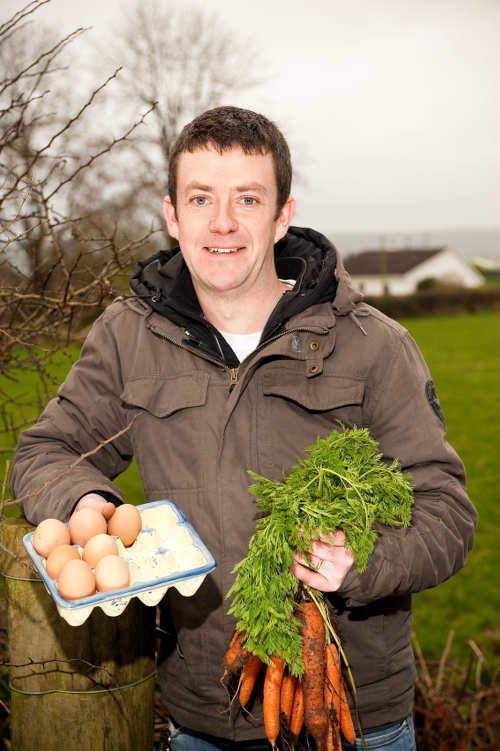Grow It Yourself - February
 Michael Kelly
Michael Kelly
2015 is the UN FAO’s Year of Soil. The year-long project aims to raise awareness in society about the ‘profound importance’ of soil for human life and promote the sustainable management of soil. FAO Director-General José Graziano da Silva said that we are not paying enough attention to soil, our ‘silent ally’, which I reckon is an understatement – as a society we’re paying no attention whatsoever to our soil.
Healthy soils he said are not only the foundation for food, fuel and medical products, but also essential to our ecosystems, playing a key role in the carbon cycle, storing and filtering water, and improving resilience to floods and droughts.
Our soils work hard. But we will work them even harder in the decades to come – population growth will require a 60% increase in food production, but instead of working to conserve and protect this precious resource, we’re literally treating it like dirt.
The world’s soil is under immense pressure – it takes 1,000 years to form a centimeter of soil, but we’re losing it permanently (and at dizzying pace) to relentless urbanization to accommodate the expanding population.
An area of soil the size of Costa Rica is lost every year and here in Europe, 11 hectares of life-giving soil are sealed under expanding cities every hour. Globally, a third of all our remaining soil is degraded from erosion, compaction, nutrient depletion and pollution. Given the role it plays in feeding us (95% of our food comes from it), Vandana Shiva says that our determined destruction of the soil globally represents a ‘species-level act of suicide’.
As GIYers we play an important part in the management of this critical resource, not only by our gentle stewardship of the soil in our own gardens, but also by developing a deeper understanding of how soil works (and sharing that knowledge with others).
Of all the things I have learned about food growing in the last ten years, a deeper understanding of the soil has been perhaps the most important (and certainly the most satisfying). I am starting to understand that food growing is not about growing plants at all, it’s about growing soil. If you get the soil right, the plants really look after themselves.
Of course that means many mucky, sweaty hours spent turning compost heaps, lugging barrows of farmyard manure or collecting seaweed, but that’s OK too – you don’t need gym membership when you’re a GIYer.
Gradually my soil here at home has come to life, no longer the heavy potters clay of when we arrived here first, but friable and teeming with life. In a previous article I called myself a ‘nutrient shepherd’ and it’s a phrase I am very fond of – for that indeed is my job here – shepherding nutrients around the place from the compost heap to the soil to the plants, to the kitchen table and back to the compost heap again.
If you need a new year’s resolution for 2015, make yours to love soil. Pick up big handfuls of it in your hands. Smell it. Stand in it in your barefeet. Care for it. Nurture it. It is literally where all life begins.
By joining GIY you help us to continue the work of supporting people just like you to grow food at home, at school, in the workplace and in the community – each year we support over 50,000 people and 800 community food growing groups and projects. It costs just €35 to join GIY for a year, and to say thanks we will send you a seasonal copy of our supporter’s magazine GROW and some GIY seeds for you to sow each quarter. We will also send you our weekly tips, news and advice ezine and offer you discounts to GIY events like the annual GIY Gathering. Join today at www.giyireland.com.
Things to Do This Month
To Do
Turn over the soil only if the weather is dry – if the soil sticks to your boots it’s too early for digging! Keep off the soil to prevent soil compaction - use timber planks to stand on for access. If you have not already done so order/buy your seeds, spuds and onion sets. “Chit” or sprout seed potatoes – put them in a container (e.g. used egg carton or empty seed tray) and leave them in a bright warm place. Check the pH of your soil – you can buy a soil pH testing kit in any garden centre. Lime your soil now if required (to reduce acidity in very acid soils), particularly important in your brassica bed.
Sow
Finally, we can sow some seeds. On a sunny windowsill indoors, in a heated greenhouse or on a heating mat: sow celery, globe artichokes, celeriac, leeks, onions, lettuce, tomatoes, peas, aubergines, peppers/chilli-peppers. In polytunnel or greenhouse: beetroot, Brussels sprouts, summer and autumn cabbage, carrots, leeks, lettuce, radish. Outside: Weather permitting you can try planting out broadbeans, spinach, kohlrabi, onion and shallot sets, Jerusalem artichokes, parsnip and early pea varieties.
Harvest
Winter cabbage and cauliflowers, Brussels sprouts, spinach, kale and leeks.
Recipe of the Month – Beetroot and Carrot Gratin
I’ve cooked this recipe from our new book GROW COOK EAT lots of times over this winter and the whole family love it. The cream and parmesan make it just decadent enough not to feel too frugal, but it still feels healthy and is a great way to cook beetroot. It’s also a sinch to make. The recipe comes originally from Michelle Darmody‘s The Cake Café.
Ingredients:
• 300g of waxy potatoes, sliced very thinly
• 4 carrots, sliced
• 3 beetroot, peeled and sliced
• a small bunch of rosemary, pulled from the stalk and chopped
• 4 cloves of garlic, sliced
• 250ml of cream
• 70g of Parmesan, grated
Directions:
Lay the sliced potato, carrots and beetroot into an ovenproof dish, sprinkling the garlic and rosemary between layers. Pour the cream over the whole lot and place into an oven heated to 180 degrees until the vegetables are soft which will take about 40 minutes. Season and sprinkle with the parmesan and place back into the oven until golden on the top. Toss the leaves and almonds in the dressing and season. Slice the gratin in four and gently transfer onto a plate. Serve with a salad on the side and with some chutney if you wish.
Tip of the Month – Tips for growing good carrots
One of the most common problems that people have with carrots is that they end up with stumped or forked roots – though the first couple might be fun to look at (particularly if they’re rude looking), after that it is just plain annoying.
There are three main causes here:
(1) Forking of roots occurs if there are stones in the soil or if the soil is very compacted. I mainly practice no dig gardening, but I do dig the carrot bed thoroughly in springtime to make sure the soil is in good nick to a spade’s depth and that any large stones are removed.
(2) Forking can also be caused by too much fresh manure or compost in the soil being added in spring. The root will literally fork off in search of a pocket of nutrients rather than growing down in search of it. If you need to feed the soil in your carrot bed, do so in the autumn.
Finally (3), carrots don’t transplant well and any disturbance to the seedling when you’re transplanting can cause forked roots. So, it’s always better to sow carrot seeds direct in the soil.
 About GIY
About GIY
GIY is a not-for-profit organisation that aims to create a healthier, more sustainable world where people grow their own food. We inspire and support people to grow food more successfully by bringing them together to share advice, tips and ideas. There are approximately 50,000 people involved in the GIY movement in Ireland, which is proudly supported by Woodies DIY.
For more information check out www.giyireland.com
Michael Kelly is a freelance journalist, author and founder of GIY Ireland.
© GIY Ireland 2015 – all rights reserved.






There are currently no comments
Leave a comment
Not a member? Register for your free membership now!
Or leave a comment by logging in with: